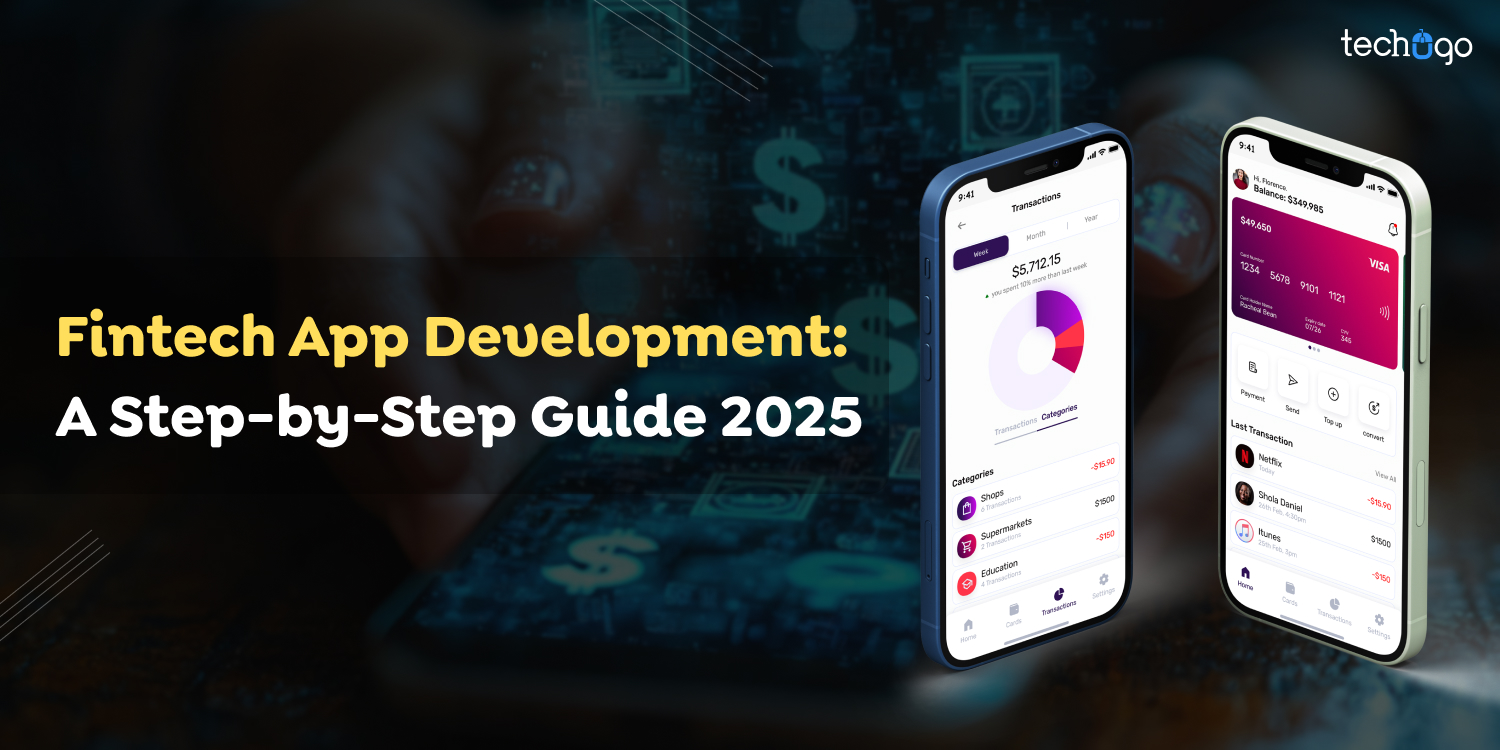20 Feb 2025
Fintech App Development: A Step-by-Step Guide 2025
Matthew Connor

The public has long sought looking for easier way to manage their money. Fintech app development is leading us into a new dimension. Fintech offers mobile apps that provide remote access to credit and insurance, online stock market investments, taxes, and foreign exchange.
From online shopping to mobile bank transfers, users frequently engage with fintech apps. Fintech app development services provide a wide range of solutions, including mobile banking, payments, investment management, and insurance. They enable individuals and businesses to take control of their finances with just a click on their phones.
By 2025, the total value of digital transactions is projected to reach CAD 14.92 trillion. The technology sector within the fintech industry is experiencing rapid growth each year. This growth underscores the importance of fintech solutions that are not only secure but also capable of meeting customer expectations.
The fintech industry is one of the most lucrative, which is why many entrepreneurs and venture capitalists invest in fintech app development. However, creating a profitable fintech application is no easy task. If you’re hoping to build a successful fintech application and explore the intersection of technology and finance, this blog post is perfect for you.
This discussion will focus on the steps needed to build a successful app for 2025 and beyond.
What is Fintech App Development?
Fintech app development is the process of designing, planning, creating, launching, and building mobile and online apps that offer fintech solutions. These apps leverage technology to simplify financial processes, including internet banking, mobile payments, investment management, and insurance.
Fintech apps can also incorporate cutting-edge technologies like blockchain, artificial intelligence, and machine learning to enhance financial functions and security. These advanced technologies ensure both full security and optimal functionality. Fintech applications are developed using a multidisciplinary approach that combines knowledge from design, finance, data analysis, software engineering, and user interface design.
Fintech app development companies offer various options for creating fintech applications, including customizable templates and ready-to-use solutions. Fintech app development can be tailored to meet the specific needs of financial businesses, as well as their requirements and timelines.
Types of Fintech Applications
The field of fintech is vast, covering not only various types of business models but also different types of custom fintech software solutions. When designing a fintech application, it’s important to be aware of the categories you’re building it for, the target customers, and how they will use the app. Here’s a look at a few of the most well-known types:
Banking apps
Digital banking applications give customers access to the full range of banking functions from the comfort of their homes. They allow users to open accounts, manage their debit and credit cards, transfer money, and make payments on mobile devices without needing to visit a physical bank branch. The most important feature is, of course, convenience, users can access their accounts 24/7 and maintain full control of their funds.
Insurance apps
InsurTech apps simplify many of the complex processes and bureaucratic paperwork associated with applying for various types of insurance coverage. These apps cover everything from pet insurance and property insurance to life insurance.
Customers can purchase insurance plans, file claims, and receive immediate assistance through customer service. InsurTech apps leverage AI-powered analysis and the Internet of Things (IoT) to better assess risk and offer insurance plans customized to an individual’s lifestyle and risk profile.
Personal Finance and Budgeting Apps
Generation Y is notoriously skeptical of traditional banks. It is also believed that they will inherit the largest sum of wealth, according to predictions. As money management becomes a significant concern for the younger generation, it’s no surprise that the demand for personal finance apps and budgeting tools is skyrocketing. These apps help people gain a better understanding of their budgeting habits, plan according to their needs, receive tax guidance, and organize their financial affairs.
Lending Apps
Peer-to-peer lending platforms provide the opportunity to secure funds for small businesses and individuals directly from users. Instead of obtaining loans from banks and paying excessive interest, users can access better alternatives, including borrowing smaller amounts of cash that they can repay without any fees.
Investing Apps
Like personal finance apps, investing apps are growing in popularity. With over 80% of young people saying they don’t expect to retire as they age, a growing number of individuals are seeking additional income sources. Investment apps offer a simple and cost-effective way for those with little to no experience to create and manage their investment portfolios. Users can consult with experts or make investment decisions more easily by using automated advisors.
Cryptocurrency Apps
These apps make the experience of using virtual currency throughout the day easier. In many ways, crypto apps connect with other fintech applications; however, instead of using cash, they use cryptocurrency coins. For example, you can store coins in a digital wallet, just like you would in a regular wallet.
Alternatively, you could use an exchange platform to convert traditional money into digital currency. When developing your app, it’s important to consider the tax treatment of crypto transactions to ensure you’re handling these financial aspects efficiently.
Benefits of Fintech App Development
Investing in fintech mobile app development offers numerous advantages for both customers and businesses alike.
Enhanced Customer Experience
One of the most crucial factors for any company is the customer experience. Through fintech mobile app development, companies can provide new ways for customers to purchase goods or services from their mobile devices.
Fintech app development enables users to perform a range of tasks using their smartphones, such as making payments, checking account balances, and completing transactions. These apps add value to companies and enhance the overall user experience for customers.
Improved Efficiency
By automating repetitive operations and procedures, fintech applications help companies operate more efficiently. The result is lower operating costs and faster service delivery, benefiting both the service provider and the client.
Market Reach
Fintech app development is designed to be a mobile-friendly solution that helps businesses reach a wider audience across various platforms, such as tablets, smartphones, and more. People who want to stay informed about the companies they love will find mobile apps more accessible and convenient.
Greater Convenience
When it comes to doing transactions, a fintech application offers greater convenience to customers. Customers no longer have to travel to a physical store or wait days for a delivery to have their purchase brought to their doorstep. Fintech applications allow users to access all the data they need right from their smartphones. Businesses can stay ahead of the competition by providing an exceptional user experience.
Enhanced Security
With the rising threat of cyberattacks, security is a top concern in the development of fintech apps. Developers are increasingly adopting sophisticated security methods such as biometric authentication, encryption, and cryptography to protect user data.
Data-Driven Insights
Fintech apps utilize data analytics to provide users with insights into their spending habits. By analyzing their spending patterns, users can make informed financial decisions while improving their overall financial well-being.
Must-Have Features Of Fintech App Development
Check out the following essential features that will help a fintech application stand out and contribute to the next generation of financial services.
Secure User Authentication
To safeguard user data, financial apps must implement security-based authentication techniques. For example, they can use two-factor authentication (2FA), which requires users to enter their account password and receive a unique number on their smartphone to confirm the authenticity of their account. Popular apps like PayPal and Robinhood utilize 2FA as an additional layer of security.
Account Integration
Fintech apps should allow users to link their bank accounts to the application. Apps like Mint or Personal Capital, for instance, integrate with bank accounts, credit cards, and investment accounts. This integration lets users view all their financial data in one place, making it easier to manage their money.
Real-Time Notifications
Fintech app development must provide real-time alerts to users about their financial transactions. Apps notify users when a transaction occurs, when there is due payment, or when their account balance drops. These notifications keep users informed about their financial standing and can help prevent unauthorized transactions.
Budgeting and Expense Tracking
The budgeting and expense tracking feature allows users to set financial goals and monitor their spending. These apps help users create budgets, categorize expenses, and present visual representations of their spending habits. This helps users understand where their money is going and make informed financial decisions for fintech application development.
AI Integration
Artificial Intelligence is used to enhance bank apps with cutting-edge improvements. The capabilities of fintech apps can be significantly boosted by incorporating AI. A fintech app that integrates AI provides a range of benefits like greater accuracy and efficiency, improved customer support, and more effective fraud detection and wealth management.
Personalization Functionality
User experience plays a crucial role in fintech mobile app development. Customizing the UX design, creating personalized menus, and offering features based on users’ preferences are key factors that can make your fintech app stand out from competitors. Technologies like AI and Big Data Analytics help analyze user behavior, allowing developers to create a seamless UI for mobile apps.
Peer-to-Peer Payments
Fintech app development enables customers to easily make peer-to-peer transactions. These apps enable app users to transfer money to friends, split bills, or make payments for goods and services. They simplify moving money between individuals and eliminate the need to carry cash or checks.
Financial Education and Resources
Fintech apps may include educational content and tools to improve users’ financial literacy. Apps like Credit Karma and NerdWallet, for example, offer videos, articles, and interactive tools to explain how to budget, clarify financial concepts, and provide advice on budgeting or improving credit scores. They empower consumers to make better financial decisions.
Mobile Wallet Integration
Integrating a mobile wallet feature allows users to store their debit and credit cards electronically within the app. Applications such as Apple Pay and Google Pay enable users to complete transactions via their phones or other wearable smart devices. This feature is convenient and promotes cashless transactions.
Investment Management
Fintech apps may offer investment management options that make it easier for people to discover and track investment opportunities. Specifically, they can offer automated portfolios based on risk profiles. These apps provide personalized advice, track portfolio performance, and offer information to help investors make informed decisions about their investments.
Loan and Credit Services
Fintech applications can include credit and loan services, which makes easier for users to access financial services. For instance, apps allow users to apply for credit, personal loans, or cards directly from the app. They offer personalized loans, calculate interest rates, and assist users throughout the application process.
Customer Support
Fintech applications should provide robust customer service options to assist users whenever they need help. Examples include live chat support, email assistance, and in-app help centers. Responsive customer support makes sure that users can resolve any questions or issues, improving their overall experience with the app.
Step-by-Step Guide to Building Fintech Apps
It’s time to break down the question of “How to develop a fintech app” into concrete steps. It requires not only extensive technical knowledge but also an understanding of the market and audience. When you partner with a fintech application development firm, you can streamline many of these processes and focus on the strengths of your business.
Market Research Focused on the Target Audience and Gaps
To begin with in creating a fintech app that attracts customers and generates revenue is to learn everything you can about the marketplace. Who are your customers? Who are your competitors? Are there gaps in the market that your app could fill? If users can find an alternative to your app, they’ll likely switch to another product, as will investors.
Create a framework similar to the key fintech capabilities we’ve previously described, and include at least one feature that will set your business apart. During your research, consider including localization in your app to appeal to people in diverse regions. Localized apps can provide an unmatched user experience across different languages and countries, making your app more appealing to a global audience.
Create a Brief for the Project, Including a Plan
Once you’ve completed your market research, you’ll be able to determine the type of fintech app that best addresses the problem. After that, begin planning your budget and features. There are many types of fintech apps you could develop. For example, a bill payment system could allow customers to pay all their bills to various companies using a barcode.
You must define the scope of your MVP (Minimum Viable Product) in a project brief. A brief for app development is a concise document that defines objectives, requirements, and potential solutions to ensure that both you and your team are aligned.
Build the Right Team
Fintech includes two major aspects that are technology and finance, and the proper mixture of the two can assist you in developing your dream solution. With a Fintech app development company, you are able to create an innovative fintech application.
Thus, make sure you hire a team of experienced developers or partner with an experienced application development firm with the right knowledge. As an example, you could consider employing an offshore app development firm that will work alongside the team on site to develop the app. It is essential to have the necessary abilities to create a successful application without any issues.
Select the Right Technology Stack
Selecting the right tech stack is crucial for creating a successful fintech application. There are many options available, and making the wrong choice can have severe negative consequences.
Depending on the type of app and the features you require, different technology tools are needed to run both the front and back end of your app. Since each app project is unique, avoid using a one-size-fits-all solution for mobile and web fintech applications.
A well-chosen technology stack can help reduce development costs, streamline software development, and speed up your app’s time to market (TTM). Additionally, choosing the right technology ensures your app’s success once it’s released. Some of the most popular technologies used in fintech apps include Python, C#, C++, Ruby, Kotlin, and Java.
Create a User-Friendly Interface
A well-designed UI/UX is essential for any app, especially fintech applications. Fintech apps are built to assist users with various financial transactions. The more complex the flow, the simpler and more intuitive the interface should be. One area where many financial apps struggle is onboarding.
Fintechs need to collect sufficient customer information to comply with regulations such as Know Your Customer (KYC) and more. Asking for too many details at the start can turn users off. What can you do? Use progressive sign-up to collect information gradually, or incorporate gamification and profile meters to provide users with a sense of accomplishment as they fill in their details. A smart UI/UX design will clearly show users how their data collection benefits them throughout the process.
Develop and Run Your MVP to Ensure Security and Compliance
With user stories, design, and an outline for the initial release ready to go, you can begin MVP development. Keep in mind that security and compliance are essential in the development of fintech apps, as they involve many moving parts. Here are some key considerations:
- Always protect your data with encryption and conduct API penetration tests to identify weaknesses in your APIs.
- It’s recommended that users be required to reset their passwords whenever they perform high-risk actions.
- When creating or testing in staging environments, only the last three digits of credit or debit card numbers should be visible.
- If you’re integrating APIs from third parties, make sure to conduct a thorough evaluation of the vendor first.
- Implement the Zero Trust security model both inside and outside of your company. This means that devices, users, and applications must be verified before granting access to sensitive information.
Launch and Maintain According to Feedback
An MVP helps you reach potential users quickly, allowing you to collect feedback and improve your product. Conduct A/B testing and record feedback from users using either a spreadsheet or a specialized usability tester. This will help you identify what is confusing or misleading for them.
To better understand user behavior, Real User Monitoring (RUM) provides valuable insights into how your user base interacts with your app. Be prepared to seek answers and make adjustments when you notice issues. The great thing about Agile development is that it allows you to continue refining the app until you have a complete solution, all without disrupting your current processes.
How Much Does It Cost to Make a Fintech Mobile App?
The cookie-cutter method is not a good fit when it comes to mobile app development. Each digital product is developed at a unique price. This is especially true for complex financial products that involve multiple connections, robust security features, and advanced technologies integrated across various levels.
Ultimately, if you plan to create a financial application, it’s important to be prepared for a range of estimates that may change frequently, especially during the initial phase when the scope of your app is expected to grow significantly as you determine what the MVP version of the app should be.
The cost of creating a fintech application typically ranges from CAD 10,000 to CAD 100,000. This is only a rough estimate; the actual cost of fintech app development depends on many factors, such as:
- Application Type
- Location
- Development Team Size
- Technology Stack
- Functionalities and Features
- Platform (iOS, Android, or Cross-Platform)
Let’s Wrap Up
Fintech has really played a key role in the development of mobile applications in Canada. Security, innovation, and user-centered design are key elements of the development process, which are easily achieved through fintech. As technology advances, so do the contributions of fintech experts and app developers, creating innovative solutions that meet the evolving needs of businesses.
The fintech industry is growing rapidly, with more customers opting for neobanks with a digital core, such as budgeting software, online insurance companies, digital wallets, and online trading platforms that support a range of traditional and cryptocurrencies. This presents the ideal opportunity to develop a fintech application and expand your business.
To stay ahead of the market, financial institutions must respond quickly to the increasing demand for fintech apps. Companies seeking to provide innovative financial services to customers may find that unique fintech app development can redefine the rules of the game.
Get In touch
We are excited to here from you and let’s start something special Together. Call Us for any inquiry.
Write us
sales@techugo.caJust a call away
About you




